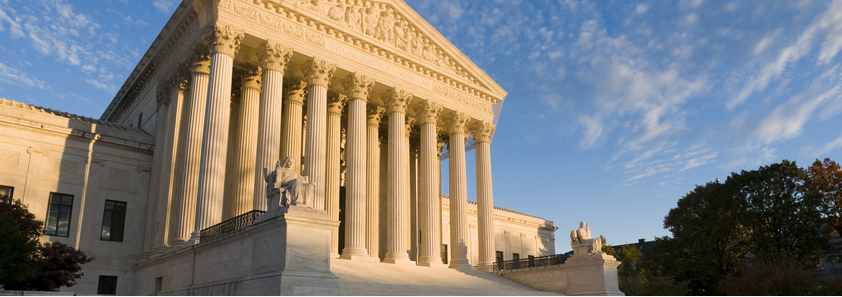On November 27, 2017, the Supreme Court heard oral argument in Oil States Energy Services, LLC v. Greene’s Energy Group, LLC, No. 16-712. The Supreme Court’s decision in this case will either spare or strike down inter partes review as a means for challenging the validity of issued patents in the United States.
Background
The America Invents Act (AIA) of 2011 established a procedure called inter partes review (IPR) through which one may challenge the validity of issued patents before the Patent Trial and Appeal Board (PTAB) of the United States Patent and Trademark Office (PTO). IPRs are conducted before a panel of three PTAB administrative law judges. There is no Article III standing requirement for initiating IPR proceedings; any person may challenge the validity of a patent through the IPR process. Challenges to validity in IPRs are limited to anticipation or obviousness challenges based upon prior art patents and publications. If the PTAB finds a patent invalid in an IPR, the patent owner may appeal the finding to the United States Court of Appeals for the Federal Circuit.
In 2014, Greene’s initiated IPR proceedings against Oil States’ U.S. Patent No. 6,179,053, which covers apparatuses and methods for securing wellhead machinery. On May 1, 2015, the PTAB found the ’053 patent invalid for anticipation. Oil States appealed the PTAB’s invalidity finding to the Federal Circuit; the Federal Circuit affirmed the PTAB’s finding on May 4, 2016.
On November 23, 2016, Oil States petitioned for certiorari. On June 17, 2017, the Supreme Court granted certiorari on one question: whether or not the IPR process violates the Constitution.
Oil States’ Supreme Court briefs advance three main arguments: (i) IPRs violate Article III of the Constitution, which grants federal courts—rather than administrative agencies such as the PTAB—the power to adjudicate issues of patent validity; (ii) although non-federal court tribunals may exercise the power to adjudicate disputes involving public rights, patents constitute private rights, not public rights; and (iii) in addition to violating Article III, IPRs violate the Seventh Amendment right to have factual disputes resolved by a jury.
Greene’s Supreme Court brief counters that (i) IPRs do not usurp Article III judicial power, but instead provide a limited, specialized procedure through which the PTO may review and correct its own patent validity determinations; (ii) patent rights emanate from federal statute, and thus constitute public rights amenable to adjudication by a federal agency; and (iii) there is no Seventh Amendment jury right in cases involving public rights.
The United States Government also filed a Supreme Court brief defending the constitutionality of IPRs.
At the November 27, 2017 oral argument, Allyson Ho argued on behalf of Oil States, Christopher Kise argued on behalf of Greene’s, and Malcolm Stewart argued on behalf of the United States.
Oil States’ Portion Of The Oral Argument
During Oil States’ portion of the oral argument, Justice Ginsburg initiated questioning by noting that “there must be some means by which the Patent Office can correct the errors that it’s made, like missing prior art that would be preclusive.” Justices Ginsburg, Kagan, Roberts and Sotomayor proceeded to ask Ms. Ho to defend Oil States’ distinction in its reply brief that the PTO’s ex parte and inter partes reexamination procedures are constitutionally permissible, whereas IPRs are not. Ms. Ho explained that reexamination procedures are “fundamentally” between the PTO and the patent owner, whereas an IPR involves a dispute between private parties. Justice Sotomayor pushed back, noting that the PTO in an IPR could proceed to a final written decision even if the challenger dropped out of the proceedings.
Justice Kennedy asked Ms. Ho questions directed toward the principle that patent owners’ expectations as to their patent rights are not unlimited or unconditional. Justice Roberts further noted that, under the takings clause of the Constitution, government regulations could diminish the value of real property: “So, if the government can restrict your property right in real property to that extent, why can’t it do so with respect to patent rights?”
Justice Gorsuch asserted that prior decisions, including McCormick Harvesting Machine Co. v. Aultman, 169 U.S. 606 (1898), “arguably” have indicated that the only authority competent to annul or correct a patent is a federal court. Justice Sotomayor, however, countered that McCormick involved a matter of statutory interpretation concerning a then-extant patent reissue statute, and did not provide a constitutional holding concerning the limits of the PTO’s power.
Justice Breyer asked Ms. Ho, “I thought it’s the most common thing in the world that agencies decide all kinds of matters through adjudicatory-type procedures often involving private parties. So what’s special about this one, or do you want to say it isn’t special and all the agency proceedings are unlawful?” Ms. Ho answered that those non-IPR agency proceedings are permissible because the government there is acting as “enforcer.” Justice Kagan, however, observed that in IPRs, the government too is the enforcer: “It’s the government trying to figure out whether it made a mistake by granting the patent, which the government sometimes does and knows it sometimes does, but the government wants to put in place a set of procedures that will actually increase the government’s accuracy in figuring out whether it made a mistake.” Justice Gorsuch noted that Ms. Ho had “struggled” with the question of “how much of an adjudication does an inquisitorial process have to have before it becomes an adjudication,” and indicated that Oil States could circumvent that struggle by “simply say[ing] that this is a private right.”
Justices Sotomayor and Ginsburg both noted that there was historical precedent for procedures like IPR: in seventeenth- and eighteenth-century England, the Privy Council, an advisory body to the Crown, had annulled patents without involving the courts.
Greene’s Portion Of The Oral Argument
During Greene’s portion of the argument, Justice Breyer initiated questioning by asking Mr. Kise whether patent owners “gain a kind of vested interest or right after enough time goes by and they rely on it sufficiently.” Mr. Kise answered “no,” but Justice Kagan then proceeded to ask whether Mr. Kise’s defense of the IPR process would change if there was no judicial review of IPR decisions by the Federal Circuit: “Then you would have to say yes, right?” Justice Sotomayor agreed, noting that “for me…what saves this, even a patent invalidity finding, can be appealed to a court.” Justice Gorsuch, however, observed that “there’s only judicial review if somebody appeals,” and that an IPR decision, “if not appealed, has all the force of law of an Article III court.”
Justice Roberts asked Mr. Kise, “your position, it strikes me, is simply that you’ve got to take the bitter with the sweet. If you want the sweet of having a patent, you’ve got to take the bitter that the government might reevaluate it at some subsequent point….Well, haven’t our cases rejected…that proposition?” Justice Roberts further raised the concern that the PTO has the ability in IPRs to alter the composition of PTAB panels to influence the outcome of IPRs. Mr. Kise responded that he didn’t believe such instances of so-called “panel stacking” had occurred on more than a few occasions.
Justice Gorsuch engaged in an extended colloquy with Mr. Kise about whether patent rights were private rights. Justice Gorsuch analogized patents to land grants, asking “Do you think it would work if – if we had land patents subject to the same circumstances, that they could be reexamined at any time over hundreds of years, even after the farmer had sold the land to the developer who built the houses and that the land patent could be revoked by the government by bureaucracy, I suppose, in the Department of Interior?”
Justice Gorsuch further asserted that “there’s an abundance of law going back 400 years” that once a patent is granted, “it’s a private right belonging to the inventor.” Justice Ginsburg countered by noting that even Oil States had acknowledged that patent rights were not absolute: “Ms. Ho, I think, wisely, recognized that the reexamination procedure between the government is okay. But – but the problem [with an IPR] is it looks too much like a court proceeding.” Mr. Kise agreed with Justice Ginsburg on this point: “The Petitioner has conceded that the power exists, the power of revocation.”
The United States’ Portion Of The Oral Argument
Justice Gorsuch initiated questioning during the United States’ portion of the oral argument by asking Mr. Stewart to address the extent to which the executive grants a patent subject to “whatever conditions in terms of its withdrawal that we wish to impose.” Mr. Stewart answered that there is no expectation on the part of a patent owner that the validity of its patent is immune from challenge in, for example, ex parte review or judicial proceedings.
Justice Roberts asked Mr. Stewart about “panel stacking”: “Does it comport to due process to change the composition of the adjudicatory body halfway through the proceeding?” Mr. Stewart answered that such changes had occurred three times in situations where the chief judge of the PTAB “was concerned that the panel as initially composed was likely to diverge from general PTAB precedent with respect to a matter that bore on the institution decision, and so the chief judge expanded the panel. It’s not clear whether the chief judge picked judges that he had a particular reason to think would be sympathetic to a particular view.”
Justice Breyer attempted to distill the government’s arguments down to three theories: (i) “Is there a problem of it’s unfair to hold these people to the new statute because… they got their patent before the statute was enacted?” (ii) “the public versus private right theory”; and (iii) “a vested right theory, which had great popularity in the 19th century and might have moved Justice Story but in fact has happily sunk from sight.” Leaving aside the doctrinal differences among those theories, Justices Gorsuch, Roberts and Breyer proceeded to express concerns over the potential consequences of depriving patent owners their rights after having committed significant investments or resources to developing those rights. But Justice Breyer noted that those concerns might be better addressed in a case arising under the takings clause or the due process clause.
Justices Kagan, Ginsburg, Gorsuch and Sotomayor asked Mr. Stewart questions concerning the limits of the PTAB’s authority, including whether constitutional concerns would arise if the IPR process did not include judicial review, or if the IPR process was expanded to permit the PTO to adjudicate infringement issues. Mr. Stewart conceded that those hypotheticals could raise constitutional issues, but answered that the IPR process was “not something the agency came up with on its own. This is an act of Congress. It’s entitled to judicial respect.”
Conclusion
Based on their comments at oral argument, Justices Roberts and Gorsuch appear to favor Oil States’ position, whereas Justices Ginsburg and Breyer appear to favor Greene’s. While Justices Kagan and Sotomayor expressed concerns about the constitutionality of the IPR process itself, those concerns appear to be assuaged by the availability of judicial review for IPR decisions. The views of the other Supreme Court Justices are less clear.
The Seventh Amendment right to trial by jury did not arise at oral argument. Thus, the two key issues upon which the Supreme Court’s decision in this case likely will turn are: (i) the extent to which the Justices view the IPR process either as an Article III adjudication or as an administrative error-correcting mechanism; and (ii) the extent to which the Justices view patent rights as public or private rights.



